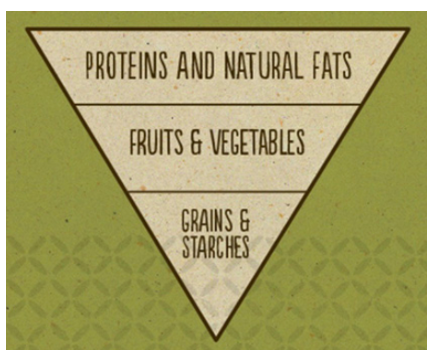Highlights
America is in the grip of a metabolic crisis, with a significant majority of the population struggling with their weight and related chronic diseases. As I argued in my earlier blog, poor diet is the root cause.
As always, prevention is better than cure. Feeding our children well is important, not only for their well-being today, but to set them up for healthier life in the long term, too. So, how do we do this? Here I set out some principles and suggestions for a family-wide approach to healthier eating.
Children (or adults) who are at a healthy weight, and whose metabolic biomarkers are normal (for more details, see the earlier blog) can maintain good metabolic health and increase the nutritional value of their food by following four simple principles.
Four Golden Rules of Eating for Good Metabolic Health
1. Eat (Mostly) Real Food
This means eating foods that are “whole,” such as chicken, peppers, celery, chickpeas, olives, blackberries, butter, eggs, carrots, cheese, green beans, walnuts, salmon, beef, whole milk, whole barley, to name a few. These foods are generally not found in fancy or branded packaging, are made from one ingredient, and can mostly be found on the outer aisles of the typical grocery store.
2. Avoid Sugar
There are three main enemies here. First, the liquid varieties: sodas, sports drinks, fruit juices (even those “pure” 100% varieties spike blood glucose and raise insulin levels). Second, refined carbohydrates, which have the same metabolic impact as sugar. Third, the hidden sugars in almost everything from yogurt and pasta sauces to salad dressings and condiments.
3. Make Friends with Fat.
Natural fats, found in nuts/nut butters, fattier meats, cheese, butter, avocados, olive and avocado oils, heavy cream, etc., offer a tasty and satiating alternative to carbs and don’t trigger blood sugar spikes. Many parents grew up in the “low fat” era and fear of fat still dominates a lot of thinking about diet. After decades of research proving that a low fat diet does not reduce risk of cardiovascular disease (the original intention of the “low fat” guidance), the government eliminated the “total fat” cap in its 2015 dietary guidelines (and then failed to publicize this major policy reversal). Fat is your family friend.
4. Choose Whole Grains, Not Refined
If your child tolerates grains and enjoys eating them, making this change will reduce the blood sugar spike that accompanies refined grain consumption. But be careful as you shop. Packaged food manufacturers (especially bread, cereal, cracker, and snack companies) have become very savvy in their misleading “whole grain” marketing and labeling practices. Most foods with a “whole grain” claim are full of refined carbs and sugar. Practical examples of genuine whole grain replacements include: replacing “quick cook” oats with the “steel cut” version; replacing white rice with brown; replacing pasta with whole barley.
For Those with Impaired Metabolic Function
If, however, your children show signs of impaired metabolic function (high triglycerides often appears first in kids), eliminating sugars, refined carbohydrates—and for some, whole grains—will generally trigger rapid improvements in metabolic health. Ensuring adequate protein and fats and focusing on lower carbohydrate fruits and vegetables will curb those cravings and normalize hunger hormones.
In short, turn that flawed Food Pyramid we grew up with upside down, like this:

Remember, It’s NOT a Diet
Eating “low-carb” for metabolic health is not a diet and should not be approached that way. To reap the benefits, it is a permanent change in how your family eats. It is not an easy transition, particularly in today’s sugar-laden, highly-processed food environment. But the rewards are great. Imagine if your family experienced:
- Healthy weight without hunger
- Improved, sustained energy levels
- Better mood regulation
- Good long-term eating habits
- Reduced risk of chronic disease
- Improved immune system function
Winning Over Your Family
For our family, the pain of revolutionizing our diet has definitely been worth the gain. Here are four strategies for making the transition easier:
- Adopt an addiction mindset. Understanding the powerful neurological and biological forces triggered by refined carbs (including sugar) consumption will increase your compassion and your resolve. Refined carbohydrates drive up glucose and insulin levels (your fat storage hormone) and wreak havoc with your hunger regulation hormones. Intense hunger is the result. No amount of willpower will succeed long-term unless you restore normal hunger levels with a metabolically healthier way of eating. If you, or your kids are “always hungry,” then ditch the sugar and carbs driving those hunger hormones and replace them with more protein and fat from real food.
- Change the food environment for everyone at home to align with a metabolically healthy way of eating. Expecting one or several members of the family to eat one way while others eat differently is unrealistic and unfair. What children eat at home will shape their taste buds, their biology, and their psychology towards food for the rest of their lives.
- Explain and frame the changes you are making to your children in age-appropriate language. Adopting these two simple family food goals is easily understood by children: less sugar, more nutritious food. Explain this as a project to make the whole family healthier. Don’t single anyone out.
- Provide alternatives. Have metabolically healthier alternatives in place from the start. Some foods are addictive. Some are consumed out of habit. Some are both. Regardless, being denied them will be experienced as a loss. Think about each family member’s favorite foods and drinks and keep a supply of alternatives in the same place the former foods lived in your kitchen. Examples include: salted or spicy nuts replacing potato chips, flavored (unsweetened) fizzy drinks replacing sodas, unsweetened hot or cold tea, whole milk, or even an unsweetened orange-flavored fizzy water as alternatives to the morning orange juice.
Meal-Specific Ideas
Here are some suggestions for making each meal of the day more healthy for your family.
Breakfast. The morning meal is indeed the most important meal of the day, but not for the reasons you think. The idea that eating “anything” for breakfast is more important than eating “nothing” has probably done more to propel the obesity epidemic than any other food myth.
Why? Because starting your day with a sugar rush triggers a cycle of sugar/carb cravings that play out the rest of the day. The worst breakfast culprits are: muffins, pastries, bagels, toast, jam, English muffins, fruit juice, pancakes/waffles, cereal, instant oatmeal, pop tarts, and breakfast bars. Replacing these with a nutritious low carb meal will make eating healthier the rest of the day much easier.
What our children eat at home will shape their taste buds, their biology, and their psychology towards food for the rest of their lives.
If your family can’t imagine eliminating the morning carb/sugar load altogether, reduce its impact by accompanying these foods with more nutritious, higher protein and higher fat foods that reduce the blood sugar spikes generated by all those refined carbs. Eggs, butter, bacon, cheese, sausages, nuts, nut butters (check for added sugar!), guacamole, and whole fruits are all good breakfast additions. A whole bagel replaced by a half bagel topped with an egg and cheese is a big metabolic and nutrition win. If your children prefer to grab a breakfast bar or pop tart on their way out the door, try replacements like deviled eggs, nuts, or cubed cheese bites.
Lunch. The midday meal is probably the most difficult meal to make metabolically healthy given what schools offer, the need for convenience, and peer challenges. The good news is that parents who have replaced the standard high carb breakfast with a more nutritious approach find that their children are much less hungry at lunchtime. They eat less, including less junk.
If your children won’t eat anything but a sandwich for lunch, change up the ratio of carbs to protein and fat by giving them a half sandwich with more protein fillings (turkey, ham, cheese, etc.) on it.
If your kids are grazers and like to snack, instead of having a meal at lunchtime, consider lower carb alternatives like hard boiled eggs, olives, hummus, cheese bites wrapped in turkey, nuts (if your school allows), and berries. Replace those juice cartons with water or whole milk.
Dinner. Many children eat significantly less protein than their bodies and brains require to be healthy and function well. This is particularly true of children who have higher sugar/carb diets. Those empty carb calories are displacing foods that provide essential nutrients.
Serving kids pasta several nights a week is a very common way that protein gets displaced from children’s diets. It is fast, cheap, easy, and most kids love it. But it has no nutritional value. In fact, it is just another form of sugar. If pasta is all your children will eat, accompany it with protein, fat, and veggies to reduce its blood sugar impact and add critical nutrients: Pasta Bolognese and Chicken Broccoli Alfredo are good examples. Another way to reduce pasta consumption is to move to a “pasta night” instead of “pasta most nights.”
Beyond the pasta challenge, metabolically healthy, nutritious dinners should consist of proteins (meats, fish, eggs, etc.) and a wide variety of vegetables. Skip the potatoes and use sauces, grated cheese, plenty of butter, and spices to make veggies and proteins more exciting and satiating.
Dessert. Many families have fallen into the nightly dessert trap. This is a hard habit to break (guilty as charged!), but it is important. First, start to eat dessert right after dinner and reduce portion sizes —both will reduce the blood sugar and insulin impact. Then start reducing how many nights a week you have dessert.
Progress, Not Perfection
If this all sounds impossible to you, join the club. I thought so too. As parents, we are fighting against the tide in so many ways. But every small step is a win, and you should celebrate every single win.
Progress, not perfection, is your goal.
There will be challenges for sure. The more addicted your children are to sugar and carbs, the more difficult this will be for them, and the angrier they may get at you about making changes to the family diet, fridge, freezer, and pantry. But diet is one of those areas of parenting where it is more important to be right than to be popular. If you’re lucky, your children will be thanking you in a matter of weeks. But even if they don’t, you can be sure they will do so in the future.
Erica Hauver is the founder and CEO of Cook Keto, a Public Benefit Corporation.












